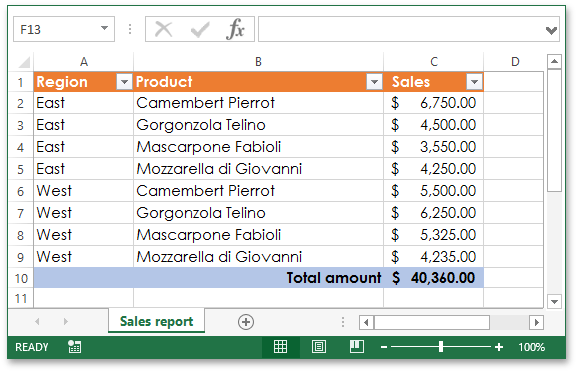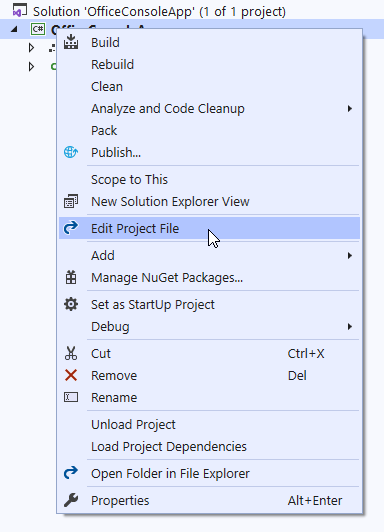Get Started - Generate an Excel File
- 16 minutes to read
Perform the steps below to get started with the Excel Export library.
Start Visual Studio and create a new Console Application (.NET Framework) project.
In the Solution Explorer, right-click the References node and select Add Reference… in the context menu.

In the invoked Reference Manager dialog, add references to the following libraries:
- DevExpress.Data.v19.2.dll
- DevExpress.Printing.v19.2.Core.dll
Paste the code below in the Main method of the Program.cs file (Main procedure of the Module1.vb file for Visual Basic).
Note
A complete sample project is available at https://github.com/DevExpress-Examples/xl-export-library-getting-started-t242354
using DevExpress.Export.Xl; using System.IO; // ... namespace XLExportExamples { class Program { static void Main(string[] args) { // Create an exporter instance. IXlExporter exporter = XlExport.CreateExporter(XlDocumentFormat.Xlsx); // Create the FileStream object with the specified file path. using (FileStream stream = new FileStream("Document.xlsx", FileMode.Create, FileAccess.ReadWrite)) { // Create a new document and begin to write it to the specified stream. using (IXlDocument document = exporter.CreateDocument(stream)) { // Add a new worksheet to the document. using (IXlSheet sheet = document.CreateSheet()) { // Specify the worksheet name. sheet.Name = "Sales report"; // Create the first column and set its width. using (IXlColumn column = sheet.CreateColumn()) { column.WidthInPixels = 100; } // Create the second column and set its width. using (IXlColumn column = sheet.CreateColumn()) { column.WidthInPixels = 250; } // Create the third column and set the specific number format for its cells. using (IXlColumn column = sheet.CreateColumn()) { column.WidthInPixels = 100; column.Formatting = new XlCellFormatting(); column.Formatting.NumberFormat = @"_([$$-409]* #,##0.00_);_([$$-409]* \(#,##0.00\);_([$$-409]* ""-""??_);_(@_)"; } // Specify cell font attributes. XlCellFormatting cellFormatting = new XlCellFormatting(); cellFormatting.Font = new XlFont(); cellFormatting.Font.Name = "Century Gothic"; cellFormatting.Font.SchemeStyle = XlFontSchemeStyles.None; // Specify formatting settings for the header row. XlCellFormatting headerRowFormatting = new XlCellFormatting(); headerRowFormatting.CopyFrom(cellFormatting); headerRowFormatting.Font.Bold = true; headerRowFormatting.Font.Color = XlColor.FromTheme(XlThemeColor.Light1, 0.0); headerRowFormatting.Fill = XlFill.SolidFill(XlColor.FromTheme(XlThemeColor.Accent2, 0.0)); // Create the header row. using (IXlRow row = sheet.CreateRow()) { using (IXlCell cell = row.CreateCell()) { cell.Value = "Region"; cell.ApplyFormatting(headerRowFormatting); } using (IXlCell cell = row.CreateCell()) { cell.Value = "Product"; cell.ApplyFormatting(headerRowFormatting); } using (IXlCell cell = row.CreateCell()) { cell.Value = "Sales"; cell.ApplyFormatting(headerRowFormatting); } } // Generate data for the sales report. string[] products = new string[] { "Camembert Pierrot", "Gorgonzola Telino", "Mascarpone Fabioli", "Mozzarella di Giovanni" }; int[] amount = new int[] { 6750, 4500, 3550, 4250, 5500, 6250, 5325, 4235 }; for (int i = 0; i < 8; i++) { using (IXlRow row = sheet.CreateRow()) { using (IXlCell cell = row.CreateCell()) { cell.Value = (i < 4) ? "East" : "West"; cell.ApplyFormatting(cellFormatting); } using (IXlCell cell = row.CreateCell()) { cell.Value = products[i % 4]; cell.ApplyFormatting(cellFormatting); } using (IXlCell cell = row.CreateCell()) { cell.Value = amount[i]; cell.ApplyFormatting(cellFormatting); } } } // Enable AutoFilter for the created cell range. sheet.AutoFilterRange = sheet.DataRange; // Specify formatting settings for the total row. XlCellFormatting totalRowFormatting = new XlCellFormatting(); totalRowFormatting.CopyFrom(cellFormatting); totalRowFormatting.Font.Bold = true; totalRowFormatting.Fill = XlFill.SolidFill(XlColor.FromTheme(XlThemeColor.Accent5, 0.6)); // Create the total row. using (IXlRow row = sheet.CreateRow()) { using (IXlCell cell = row.CreateCell()) { cell.ApplyFormatting(totalRowFormatting); } using (IXlCell cell = row.CreateCell()) { cell.Value = "Total amount"; cell.ApplyFormatting(totalRowFormatting); cell.ApplyFormatting(XlCellAlignment.FromHV(XlHorizontalAlignment.Right, XlVerticalAlignment.Bottom)); } using (IXlCell cell = row.CreateCell()) { // Add values in the cell range C2 through C9 using the SUBTOTAL function. cell.SetFormula(XlFunc.Subtotal(XlCellRange.FromLTRB(2, 1, 2, 8), XlSummary.Sum, true)); cell.ApplyFormatting(totalRowFormatting); } } } } } // Open the XLSX document using the default application. System.Diagnostics.Process.Start("Document.xlsx"); } } }Run the project.
The following image shows the XLSX file generated after the above-mentioned code is executed (the document is opened in Microsoft® Excel®).

Start Visual Studio and create a new Console Application (.NET Core) project.
Install the DevExpress.Document.Processor or DevExpress.Printing.Core NuGet package.
Important
You need a license to the DevExpress Office File API or DevExpress Universal Subscription to use the DevExpress.Document.Processor package in production code.
Paste the code below in the Main method of the Program.cs file (Main procedure of the Module1.vb file for Visual Basic).
using DevExpress.Export.Xl; using System.IO; // ... namespace XLExportExamples { class Program { static void Main(string[] args) { // Create an exporter instance. IXlExporter exporter = XlExport.CreateExporter(XlDocumentFormat.Xlsx); // Create the FileStream object with the specified file path. using (FileStream stream = new FileStream("Document.xlsx", FileMode.Create, FileAccess.ReadWrite)) { // Create a new document and begin to write it to the specified stream. using (IXlDocument document = exporter.CreateDocument(stream)) { // Add a new worksheet to the document. using (IXlSheet sheet = document.CreateSheet()) { // Specify the worksheet name. sheet.Name = "Sales report"; // Create the first column and set its width. using (IXlColumn column = sheet.CreateColumn()) { column.WidthInPixels = 100; } // Create the second column and set its width. using (IXlColumn column = sheet.CreateColumn()) { column.WidthInPixels = 250; } // Create the third column and set the specific number format for its cells. using (IXlColumn column = sheet.CreateColumn()) { column.WidthInPixels = 100; column.Formatting = new XlCellFormatting(); column.Formatting.NumberFormat = @"_([$$-409]* #,##0.00_);_([$$-409]* \(#,##0.00\);_([$$-409]* ""-""??_);_(@_)"; } // Specify cell font attributes. XlCellFormatting cellFormatting = new XlCellFormatting(); cellFormatting.Font = new XlFont(); cellFormatting.Font.Name = "Century Gothic"; cellFormatting.Font.SchemeStyle = XlFontSchemeStyles.None; // Specify formatting settings for the header row. XlCellFormatting headerRowFormatting = new XlCellFormatting(); headerRowFormatting.CopyFrom(cellFormatting); headerRowFormatting.Font.Bold = true; headerRowFormatting.Font.Color = XlColor.FromTheme(XlThemeColor.Light1, 0.0); headerRowFormatting.Fill = XlFill.SolidFill(XlColor.FromTheme(XlThemeColor.Accent2, 0.0)); // Create the header row. using (IXlRow row = sheet.CreateRow()) { using (IXlCell cell = row.CreateCell()) { cell.Value = "Region"; cell.ApplyFormatting(headerRowFormatting); } using (IXlCell cell = row.CreateCell()) { cell.Value = "Product"; cell.ApplyFormatting(headerRowFormatting); } using (IXlCell cell = row.CreateCell()) { cell.Value = "Sales"; cell.ApplyFormatting(headerRowFormatting); } } // Generate data for the sales report. string[] products = new string[] { "Camembert Pierrot", "Gorgonzola Telino", "Mascarpone Fabioli", "Mozzarella di Giovanni" }; int[] amount = new int[] { 6750, 4500, 3550, 4250, 5500, 6250, 5325, 4235 }; for (int i = 0; i < 8; i++) { using (IXlRow row = sheet.CreateRow()) { using (IXlCell cell = row.CreateCell()) { cell.Value = (i < 4) ? "East" : "West"; cell.ApplyFormatting(cellFormatting); } using (IXlCell cell = row.CreateCell()) { cell.Value = products[i % 4]; cell.ApplyFormatting(cellFormatting); } using (IXlCell cell = row.CreateCell()) { cell.Value = amount[i]; cell.ApplyFormatting(cellFormatting); } } } // Enable AutoFilter for the created cell range. sheet.AutoFilterRange = sheet.DataRange; // Specify formatting settings for the total row. XlCellFormatting totalRowFormatting = new XlCellFormatting(); totalRowFormatting.CopyFrom(cellFormatting); totalRowFormatting.Font.Bold = true; totalRowFormatting.Fill = XlFill.SolidFill(XlColor.FromTheme(XlThemeColor.Accent5, 0.6)); // Create the total row. using (IXlRow row = sheet.CreateRow()) { using (IXlCell cell = row.CreateCell()) { cell.ApplyFormatting(totalRowFormatting); } using (IXlCell cell = row.CreateCell()) { cell.Value = "Total amount"; cell.ApplyFormatting(totalRowFormatting); cell.ApplyFormatting(XlCellAlignment.FromHV(XlHorizontalAlignment.Right, XlVerticalAlignment.Bottom)); } using (IXlCell cell = row.CreateCell()) { // Add values in the cell range C2 through C9 using the SUBTOTAL function. cell.SetFormula(XlFunc.Subtotal(XlCellRange.FromLTRB(2, 1, 2, 8), XlSummary.Sum, true)); cell.ApplyFormatting(totalRowFormatting); } } } } } // Open the XLSX document using the default application. Process.Start(new ProcessStartInfo("Document.xlsx"){UseShellExecute = true}); } } }Run the project.
The following image shows the XLSX file generated after the above-mentioned code is executed (the document is opened in Microsoft® Excel®).

Start Visual Studio and create a new Console Application (.NET Core) project.
Install the DevExpress.WindowsDesktop.Document.Processor or DevExpress.WindowsDesktop.Core NuGet package.
Important
You need a license to the DevExpress Office File API or DevExpress Universal Subscription to use the DevExpress.WindowsDesktop.Document.Processor package in production code.
Right-click the project in the Solution Explorer and select Edit Project File.

Change the project’s SDK attribute to Microsoft.NET.Sdk.WindowsDesktop and set the UseWindowsForms option to true.
<Project Sdk="Microsoft.NET.Sdk.WindowsDesktop"> <PropertyGroup> <OutputType>Exe</OutputType> <TargetFramework>netcoreapp3.0</TargetFramework> <UseWindowsForms>true</UseWindowsForms> </PropertyGroup> </Project>Paste the code below in the Main method of the Program.cs file (Main procedure of the Module1.vb file for Visual Basic).
using DevExpress.Export.Xl; using System.IO; // ... namespace XLExportExamples { class Program { static void Main(string[] args) { // Create an exporter instance. IXlExporter exporter = XlExport.CreateExporter(XlDocumentFormat.Xlsx); // Create the FileStream object with the specified file path. using (FileStream stream = new FileStream("Document.xlsx", FileMode.Create, FileAccess.ReadWrite)) { // Create a new document and begin to write it to the specified stream. using (IXlDocument document = exporter.CreateDocument(stream)) { // Add a new worksheet to the document. using (IXlSheet sheet = document.CreateSheet()) { // Specify the worksheet name. sheet.Name = "Sales report"; // Create the first column and set its width. using (IXlColumn column = sheet.CreateColumn()) { column.WidthInPixels = 100; } // Create the second column and set its width. using (IXlColumn column = sheet.CreateColumn()) { column.WidthInPixels = 250; } // Create the third column and set the specific number format for its cells. using (IXlColumn column = sheet.CreateColumn()) { column.WidthInPixels = 100; column.Formatting = new XlCellFormatting(); column.Formatting.NumberFormat = @"_([$$-409]* #,##0.00_);_([$$-409]* \(#,##0.00\);_([$$-409]* ""-""??_);_(@_)"; } // Specify cell font attributes. XlCellFormatting cellFormatting = new XlCellFormatting(); cellFormatting.Font = new XlFont(); cellFormatting.Font.Name = "Century Gothic"; cellFormatting.Font.SchemeStyle = XlFontSchemeStyles.None; // Specify formatting settings for the header row. XlCellFormatting headerRowFormatting = new XlCellFormatting(); headerRowFormatting.CopyFrom(cellFormatting); headerRowFormatting.Font.Bold = true; headerRowFormatting.Font.Color = XlColor.FromTheme(XlThemeColor.Light1, 0.0); headerRowFormatting.Fill = XlFill.SolidFill(XlColor.FromTheme(XlThemeColor.Accent2, 0.0)); // Create the header row. using (IXlRow row = sheet.CreateRow()) { using (IXlCell cell = row.CreateCell()) { cell.Value = "Region"; cell.ApplyFormatting(headerRowFormatting); } using (IXlCell cell = row.CreateCell()) { cell.Value = "Product"; cell.ApplyFormatting(headerRowFormatting); } using (IXlCell cell = row.CreateCell()) { cell.Value = "Sales"; cell.ApplyFormatting(headerRowFormatting); } } // Generate data for the sales report. string[] products = new string[] { "Camembert Pierrot", "Gorgonzola Telino", "Mascarpone Fabioli", "Mozzarella di Giovanni" }; int[] amount = new int[] { 6750, 4500, 3550, 4250, 5500, 6250, 5325, 4235 }; for (int i = 0; i < 8; i++) { using (IXlRow row = sheet.CreateRow()) { using (IXlCell cell = row.CreateCell()) { cell.Value = (i < 4) ? "East" : "West"; cell.ApplyFormatting(cellFormatting); } using (IXlCell cell = row.CreateCell()) { cell.Value = products[i % 4]; cell.ApplyFormatting(cellFormatting); } using (IXlCell cell = row.CreateCell()) { cell.Value = amount[i]; cell.ApplyFormatting(cellFormatting); } } } // Enable AutoFilter for the created cell range. sheet.AutoFilterRange = sheet.DataRange; // Specify formatting settings for the total row. XlCellFormatting totalRowFormatting = new XlCellFormatting(); totalRowFormatting.CopyFrom(cellFormatting); totalRowFormatting.Font.Bold = true; totalRowFormatting.Fill = XlFill.SolidFill(XlColor.FromTheme(XlThemeColor.Accent5, 0.6)); // Create the total row. using (IXlRow row = sheet.CreateRow()) { using (IXlCell cell = row.CreateCell()) { cell.ApplyFormatting(totalRowFormatting); } using (IXlCell cell = row.CreateCell()) { cell.Value = "Total amount"; cell.ApplyFormatting(totalRowFormatting); cell.ApplyFormatting(XlCellAlignment.FromHV(XlHorizontalAlignment.Right, XlVerticalAlignment.Bottom)); } using (IXlCell cell = row.CreateCell()) { // Add values in the cell range C2 through C9 using the SUBTOTAL function. cell.SetFormula(XlFunc.Subtotal(XlCellRange.FromLTRB(2, 1, 2, 8), XlSummary.Sum, true)); cell.ApplyFormatting(totalRowFormatting); } } } } } // Open the XLSX document using the default application. Process.Start(new ProcessStartInfo("Document.xlsx"){UseShellExecute = true}); } } }Run the project.
The following image shows the XLSX file generated after the above-mentioned code is executed (the document is opened in Microsoft® Excel®).
